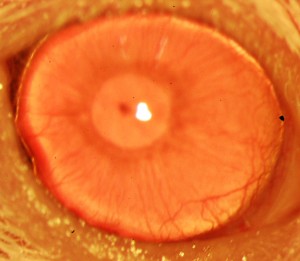
A restored, clear cornea grown from ABCB5-positive limbal stem cells. (Image courtesy of the researchers)
How cancer research led to a regenerative treatment for blindness.
Results have therefore been mixed. “Limbal stem cells are very rare, and successful transplants are dependent on these rare cells,” says Bruce Ksander, PhD, of the Massachusetts Eye and Ear/Schepens Eye Research Institute. “If you have a limbal stem cell deficiency and receive a transplant that does not contain stem cells, the cornea will become opaque again.”
Limbal stem cells have been sought for over a decade. That’s where a “tracer” molecule called ABCB5—first studied in the context of cancer—comes in.
As reported in Nature last week, Ksander and collaborators at Boston Children’s Hospital, Brigham and Women’s Hospital and the VA Boston Healthcare System were able to use an antibody to ABCB5 to isolate limbal stem cells from adult human donors. Transplanted onto the eyes of mice, the limbal stem cell mixture sparked growth of clear, anatomically correct corneas—confirmed by two-photon microscopy to analyze the tissue structure.
“In every aspect, this was a normal cornea,” says Ksander. “It was avascular, had all the layers of a normal cornea, and the correct thickness, with a normal stroma underneath it.”
A bouncer for cancer cells
ABCB5+ cells are bad actors in cancer, but also turn out to be involved in normal development. (Image: leftover bacon/OpenClipArt)
The Franks were also working with Ksander to study the presence of ABCB5 in two types of ocular cancer: retinoblastoma and uveal melanoma. Returning from an American Association of Cancer Research meeting in Washington, Markus Frank and Ksander found themselves on the same train. Frank changed his seat, and shared his lab’s latest data on ABCB5’s function in the skin—as well as its presence in the eye. Since the cornea is the “skin” that covers the eye, that gave the researchers an idea: They decided to test whether ABCB5 was important in the cornea’s development.
“I still have pages and pages of notes from that meeting,” recalls Ksander. “It was the shortest 6-hour train ride I’ve ever been on.”
Teaming up, and using a mouse model developed by the Frank lab, they found that ABCB5 is not only present on limbal stem cells, but is required for their maintenance and survival, preventing cell death through apoptosis. They further showed that when mice were unable to make functional ABCB5 molecules, they lost their populations of limbal stem cells and their corneas healed poorly after injury. But when the team transplanted limbal stem cells isolated from a deceased human donor, the animals’ corneas became like new.
“This finding will now make it much easier to restore the corneal surface,” says Ksander. “It’s a very good example of basic research moving quickly to a translational application.”
It’s also one of the first examples of using stem cells derived from adult human cells to construct a complete tissue.
“The mouse model allowed us for the first time to understand the role ABCB5 in normal development,” adds Natasha Frank, who is also affiliated with the Harvard Stem Cell Institute. “This should be very important to the stem cell field in general.”
Next steps
In theory, a person with a good, unaffected eye could donate his or her own limbal stem cells, with the help of an antibody to ABCB5 to home in on them. Markus Frank is working with the biopharmaceutical industry to develop a clinical-grade ABCB5 antibody.
“We can now utilize homogeneous, molecularly defined limbal stem cell populations for transplantation, a critical advantage in seeking regulatory approval of this technique,” he says.
The study also highlights the importance of cross-institution collaboration in science. “A single lab cannot do a study like this,” says Natasha Frank. “It integrates genetics, knockout mice, antibodies, transplantation—a lot of technical expertise that we were lucky came together in a very nice way.”







